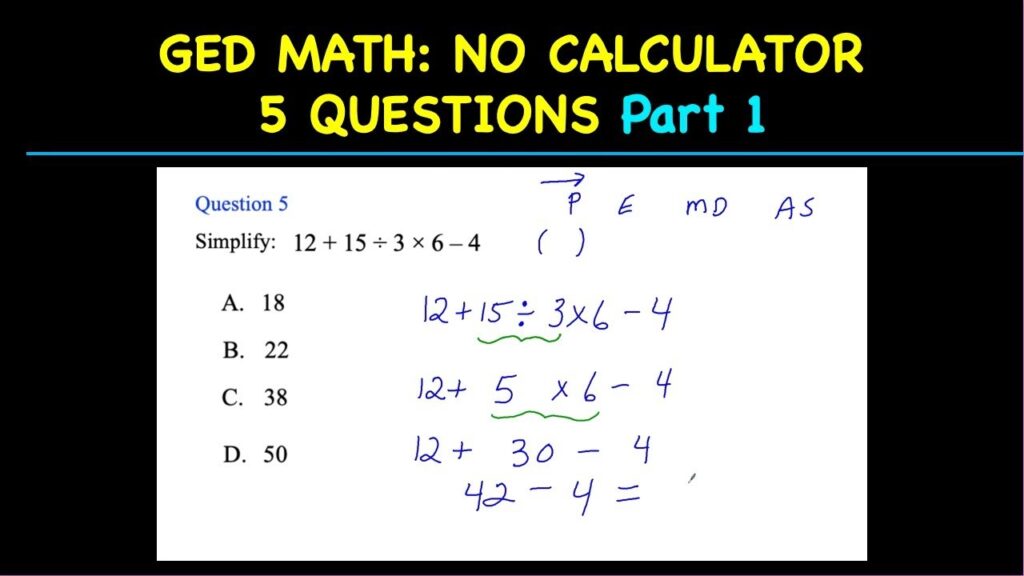Overview of the GED Test
The GED test is divided into four main subjects:
- Reasoning Through Language Arts (RLA)
- Mathematical Reasoning
- Science
- Social Studies
Each subject covers a range of topics and skills necessary for high school equivalency and postsecondary readiness.
Purpose of the GED Test
The GED test is designed to assess whether a test-taker has the knowledge and skills equivalent to those of a high school graduate. It evaluates reading comprehension, writing, mathematical reasoning, science understanding, and social studies knowledge.
Format of the GED Test
The GED test is primarily computer-based, with various question formats, including:
- Multiple Choice
- Fill-in-the-Blank
- Drag-and-Drop
- Hot Spot
- Short Answer
- Essay
This variety helps to assess a wide range of skills and knowledge effectively.
Breakdown of Questions by Subject
1. Reasoning Through Language Arts (RLA)
- Total Questions: Approximately 50-55 questions
- Time Allotted: 150 minutes (includes a 10-minute break)
- Structure:
- Part 1: 35 minutes for content questions
- Part 2: 45 minutes for an extended response (essay)
- Part 3: 60 minutes for additional content questions
The RLA section assesses reading comprehension, writing skills, and the ability to analyze and interpret texts.
2. Mathematical Reasoning
- Total Questions: Approximately 40-45 questions
- Time Allotted: 115 minutes
- Structure:
- Part 1: 5 questions (no calculator allowed)
- Part 2: 40 questions (calculator allowed)
This section evaluates quantitative problem-solving and algebraic reasoning.
3. Science
- Total Questions: Approximately 30-35 questions
- Time Allotted: 90 minutes
- Structure:
- Questions cover life science, physical science, and earth and space science, with a focus on data analysis and interpretation.
The Science section assesses the ability to understand scientific concepts and apply them to real-world situations.
4. Social Studies
- Total Questions: Approximately 30-35 questions
- Time Allotted: 70 minutes
- Structure:
- Questions focus on civics and government, U.S. history, economics, and geography.
The Social Studies section evaluates knowledge of historical events, governmental systems, and economic principles.
Summary Table of GED Test Structure
| Subject | Total Questions | Time Allotted | Additional Notes |
|---|---|---|---|
| Reasoning Through Language Arts | 50-55 | 150 minutes (with break) | Includes essay component |
| Mathematical Reasoning | 40-45 | 115 minutes | First part no calculator, second part allows calculator |
| Science | 30-35 | 90 minutes | Focus on data interpretation and scientific concepts |
| Social Studies | 30-35 | 70 minutes | Covers civics, history, economics, and geography |
Scoring of the GED Test
The GED test is scored on a scale from 100 to 200 for each subject. To pass, a test-taker must achieve a minimum score of 145 on each subject. The scoring system is designed to reflect the test-taker’s proficiency and readiness for postsecondary education or employment.
Scoring Breakdown
- Not Passing: Below 145
- Passing: 145-164
- College Ready: 165-174
- College Ready + Credit: 175 and above
Preparing for the GED Test
Study Resources
To prepare for the GED test, test-takers can utilize various study resources, including:
- Official GED Study Guides: Available through the GED Testing Service website.
- Practice Tests: Many websites offer free or paid practice tests to help familiarize test-takers with the format and types of questions.
- Online Courses: Various educational platforms provide courses specifically designed to help prepare for the GED.
Test-Taking Tips
- Familiarize Yourself with the Test Format: Understanding the types of questions and the structure of the test can help reduce anxiety on test day.
- Practice Time Management: Each section has a specific time limit, so practicing under timed conditions can be beneficial.
- Review Basic Concepts: Ensure a solid understanding of fundamental concepts in math, science, social studies, and language arts.
- Take Care of Yourself: Get plenty of rest before the test and stay hydrated to ensure optimal performance.
Frequently Asked Questions (FAQ)
Q1: How many questions are on the GED test?
A1: The GED test consists of approximately 50-55 questions in the Reasoning Through Language Arts section, 40-45 questions in the Mathematical Reasoning section, 30-35 questions in the Science section, and 30-35 questions in the Social Studies section.
Q2: What is the total time allowed for the GED test?
A2: The total time varies by subject, with the longest being the Reasoning Through Language Arts at 150 minutes, followed by Mathematical Reasoning at 115 minutes, Science at 90 minutes, and Social Studies at 70 minutes.
Q3: Is the GED test computer-based?
A3: Yes, the GED test is primarily computer-based, allowing for various question formats and interactive elements.
Q4: How is the GED test scored?
A4: Each subject is scored on a scale from 100 to 200, with a passing score of 145 required for each subject.
Q5: Can I take the GED test online?
A5: The GED test must be taken at an official testing center. However, some practice tests and study resources are available online.
Q6: How often can I retake the GED test if I do not pass?
A6: Test-takers can retake any subject test up to three times a year. It is advisable to prepare thoroughly before retaking the test.
Q7: Are there any age requirements to take the GED test?
A7: Generally, test-takers must be at least 16 years old, but specific age requirements may vary by state. It is essential to check local regulations.
Q8: What resources are available for GED test preparation?
A8: Resources include official study guides, practice tests, online courses, and community education programs.
Q9: Can I take the GED test in Spanish?
A9: Yes, the GED test is available in Spanish in some states. Check with local testing centers for availability.
Q10: Where can I find more information about the GED test?
A10: For detailed information, you can visit the GED Testing Service website or refer to the Wikipedia page.
Conclusion
The GED test is a vital pathway for individuals seeking to demonstrate their high school equivalency and improve their educational and career prospects. Understanding the structure, number of questions, and preparation strategies is crucial for success. By utilizing available resources and practicing effectively, test-takers can confidently approach the GED test and achieve their goals.



